Hybrid bike pedals are a relatively recent innovation in pedal design in which two functions are combined within the one pedal.
The advantages are many, the disadvantages few—I cover these as well as everything else you need to know about this flexible pedal type.
Since there are many types of hybrid bike pedals available on the market, I also look at the merits of a number of basic types to help you think through the possibilities in relation to the modes of cycling you want to do.
CONTENTS
Hybrid Bike Pedals Give You Flexibility
Brackets, Cleats, & Platforms (how ‘hybrid’ works)
Hybrid Bike Pedal Models & Options
Hybrid ‘Pop Up’ Pedals
Removing and Installing Hybrid Bike Pedals
HYBRID BIKE PEDALS = Flexibility
One set of single-purpose pedals?
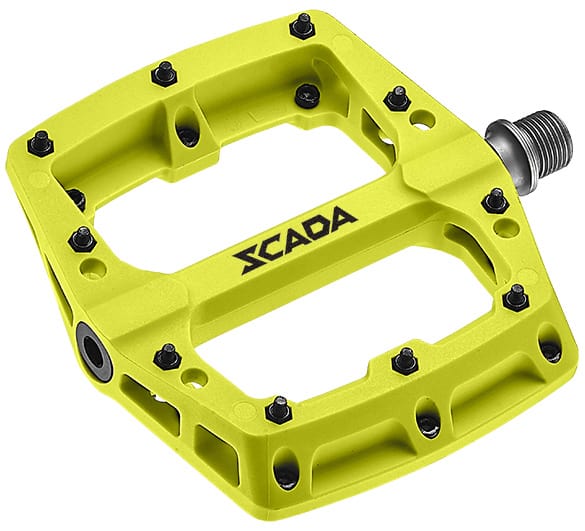
Lime 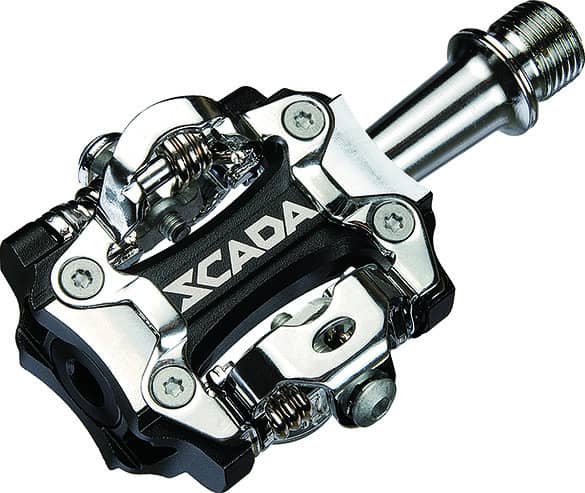
Two sets of pedals?
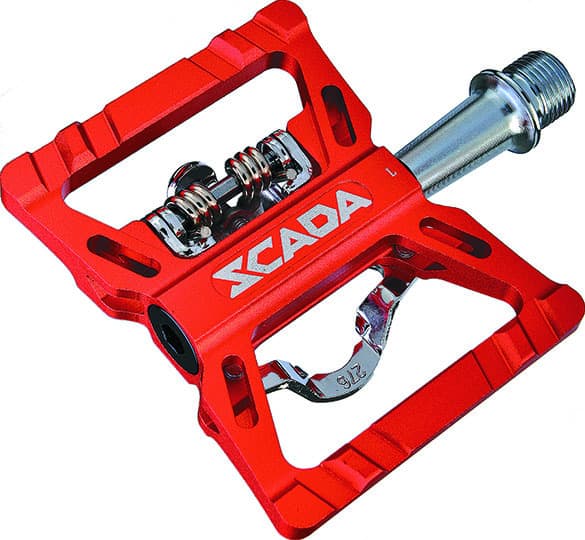
Or one set of hybrid pedals?
Pedal Choices
Having two (or more) pairs of pedals is an option where you want to maximize performance in a particular cycling discipline, or you are seeking something elegant as well as functional, a city or commuting bike for example.
Which pedal pairs you include in your kit will depend on what sort of riding you are expecting to do on a particular day, especially in light of the conditions you expect to encounter.
Now, sure, at first glance, that may seem an expensive way to make sure you have the exact equipment for the conditions.
But viewed as a percentage of the overall cost of your bike, an extra pair should come in well under 10%.
Plus you will be spreading pedal usage across pairs thus reducing the wear and tear on any one pair.
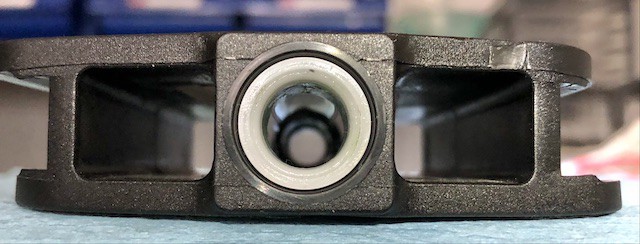
This means a cheaper model with nylon bushings rather than sealed bearings, for example, may be appropriate.
Of course, the major challenge is learning to quickly remove one set of pedals, then install the other, for which the right tool and the right technique in using that tool is essential.
However, fitting hybrid bike pedals means you can avoid having to swap one pair for the other.
The Advantage of Hybrid Bike Pedals
Hybrid bike pedals offer the flexibility of accessing multiple functionality in one pedal pair—no need to give even a moment’s though to taking the possibly excessive step of purchasing two (or more?) pairs.
The strict definition of hybrid is the combination of two elements to create a new unit.
In other words a pair of binaries combine into a unique synthesis.
Hybrid pedals combine two diametrically opposed functional modes in the one unit—they are generally flat on one side and have a bracket that accepts a clipless pedal cleat on the other.
The the foot-to-pedal connection may not be the most important dimension of cycling safely and efficiently, but there is nothing more important.
The trajectory of pedal design in recent decades has aimed at keeping foot and pedal intimately connected.
The broad surface of the modern flat pedal offers good purchase where clipping in is not necessary or even inhibits performance.
But the clipless pedal’s greater efficiency makes it superior to flat pedals where small advantages accrue from achieving maximum efficiency in each pedal stroke.
BRACKETS & CLEATS + PLATFORM
Having a clip-in bracket on one side and a broad (and usually reduced-slip) surface on the other gives a cyclist the best of both worlds.
Clipless
The evolution of flat pedals to clipless came about from the quest to improve cycling efficiency.
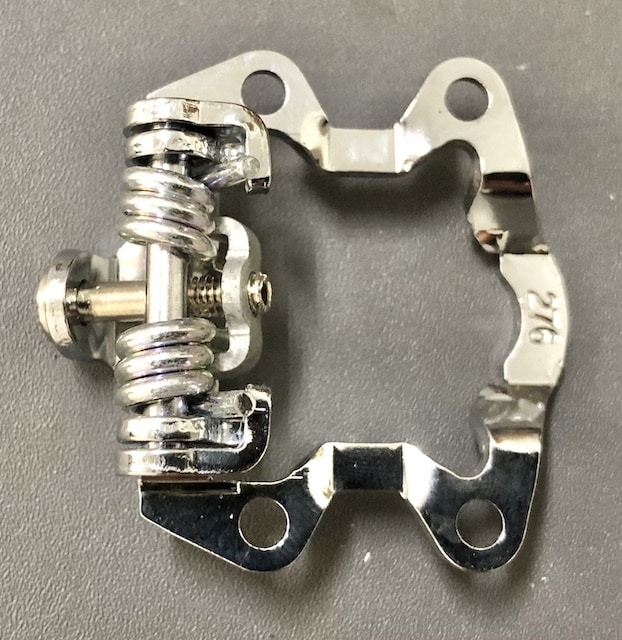
Clipping in by means of a cleat-to-pedal-bracket interface enables a cyclist to increase their energy input into the drive train.
This energy is produced from the dead half of the pedal stroke cycle, the return from the bottom to the top.
You only get drive from a flat pedal on the downstroke (puts the “push” into “pushbike”).
The cleat gives the leverage enabling a rider to “pull” the crank from the bottom to the top.
Cyclists looking for a performance edge, whether on the road or a trail, have the most to benefit from this.
Cleats clipped into pedals, moreover, also enable a rider to maintain contact between foot and pedal in wet or rough conditions.
Again, it all depends on what level of performance you are looking for.
Sports cyclists who ride for general fitness or purely recreational purposes can do without clipless pedals—any number of flat pedal designs are appropriate.
Clipping-in, and particularly clipping out, can be hazardous; even experienced cyclists can bungle shoe release and be unable to clip out in an emergency.
And, arguably, the less energy efficient and thus the more energy you burn for fitness purposes, as opposed to racing, the better.
Generally speaking, having a high-performance platform in the one pedal is a bonus, to say the least.
Brackets—not pedal body
High-performance clipless pedals don’t have a bracket for the cleat, since the pedal body performs that function.
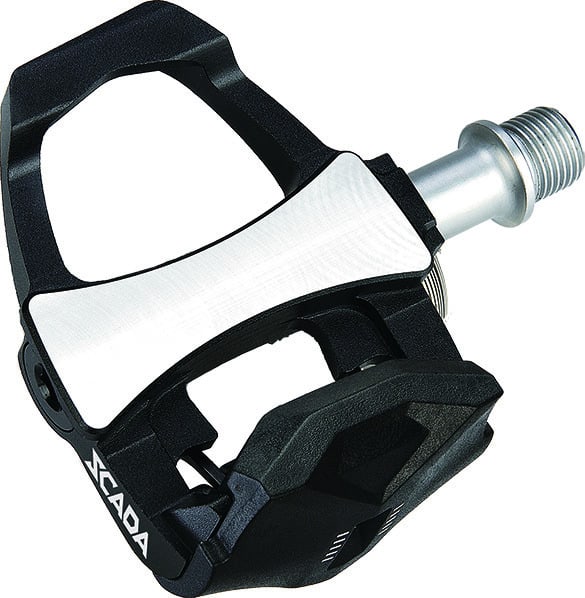
The clipless pedal form you are no doubt familiar with.
The foundational shape of hybrid bike pedals, however, is rectangular—the platform is the base within which, or to which, a cleat bracket is attached
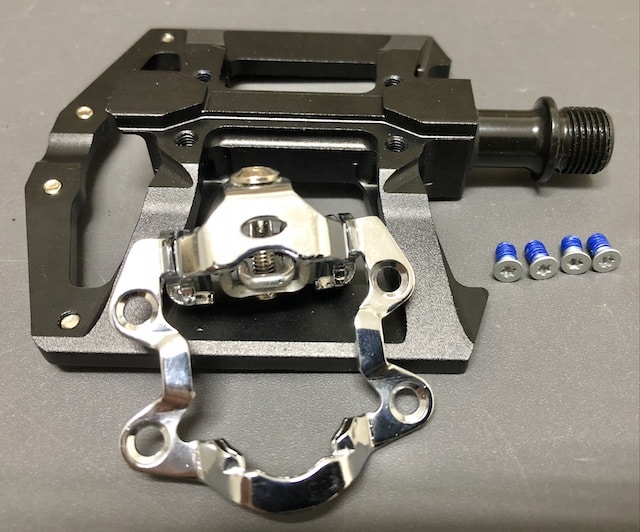
Advantages include being able to:
- replace a damaged bracket
- disassemble for thorough cleaning
Remember, hybrid bike pedals do not target high-performance, but flexibility and convenience.
Flat Platform
A platform enhanced with the addition of pins across its surface is standard on flat pedals nowadays.
Corrugations are often a feature of platform pedals and are better than nothing for enhancing shoe-to-surface grip.
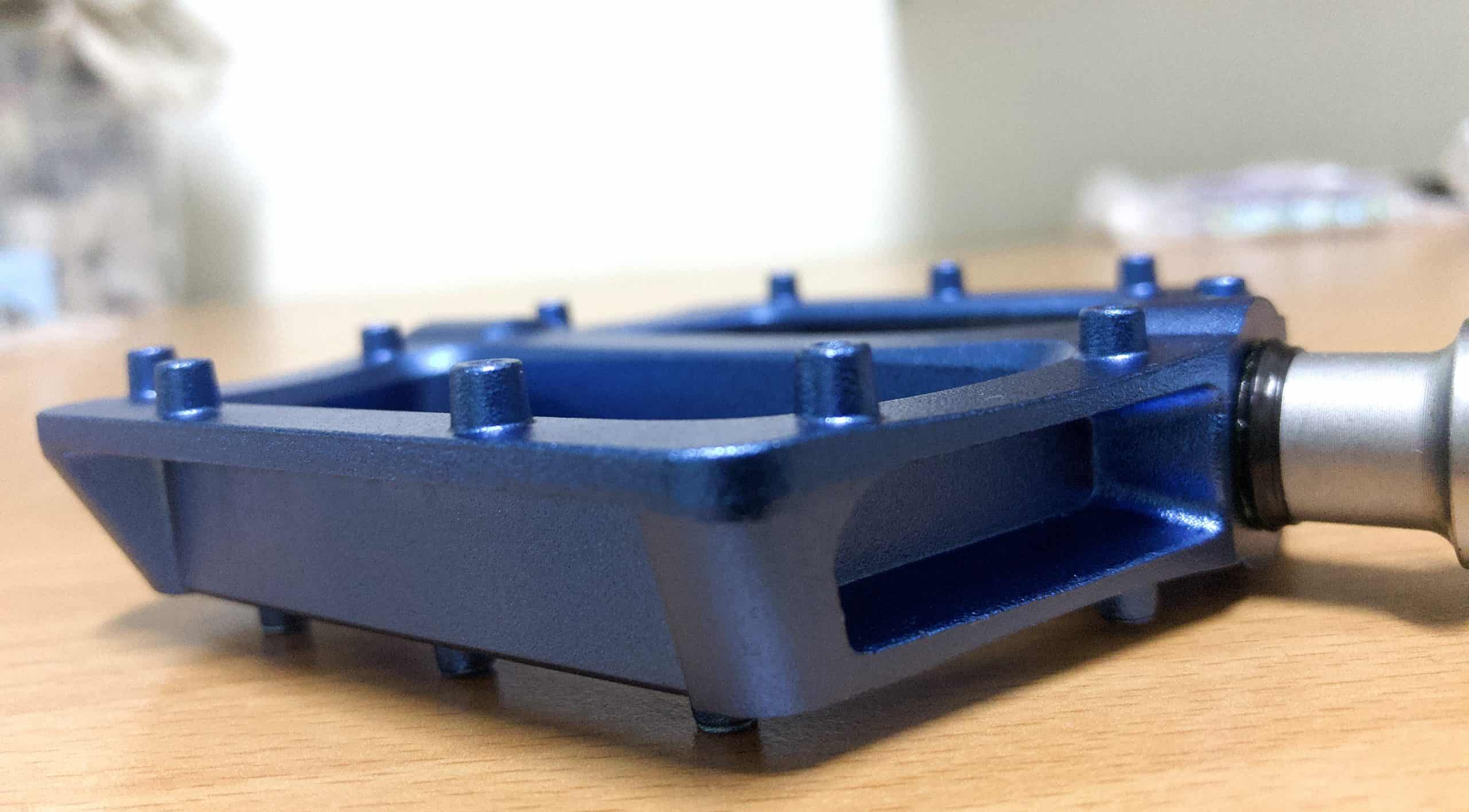
Pins, however, firmly anchor a shoe in place on the flat pedal’s surface, significantly resisting slippage under even light contact.
Pins are often cast as a part of the pedal body, built-in.
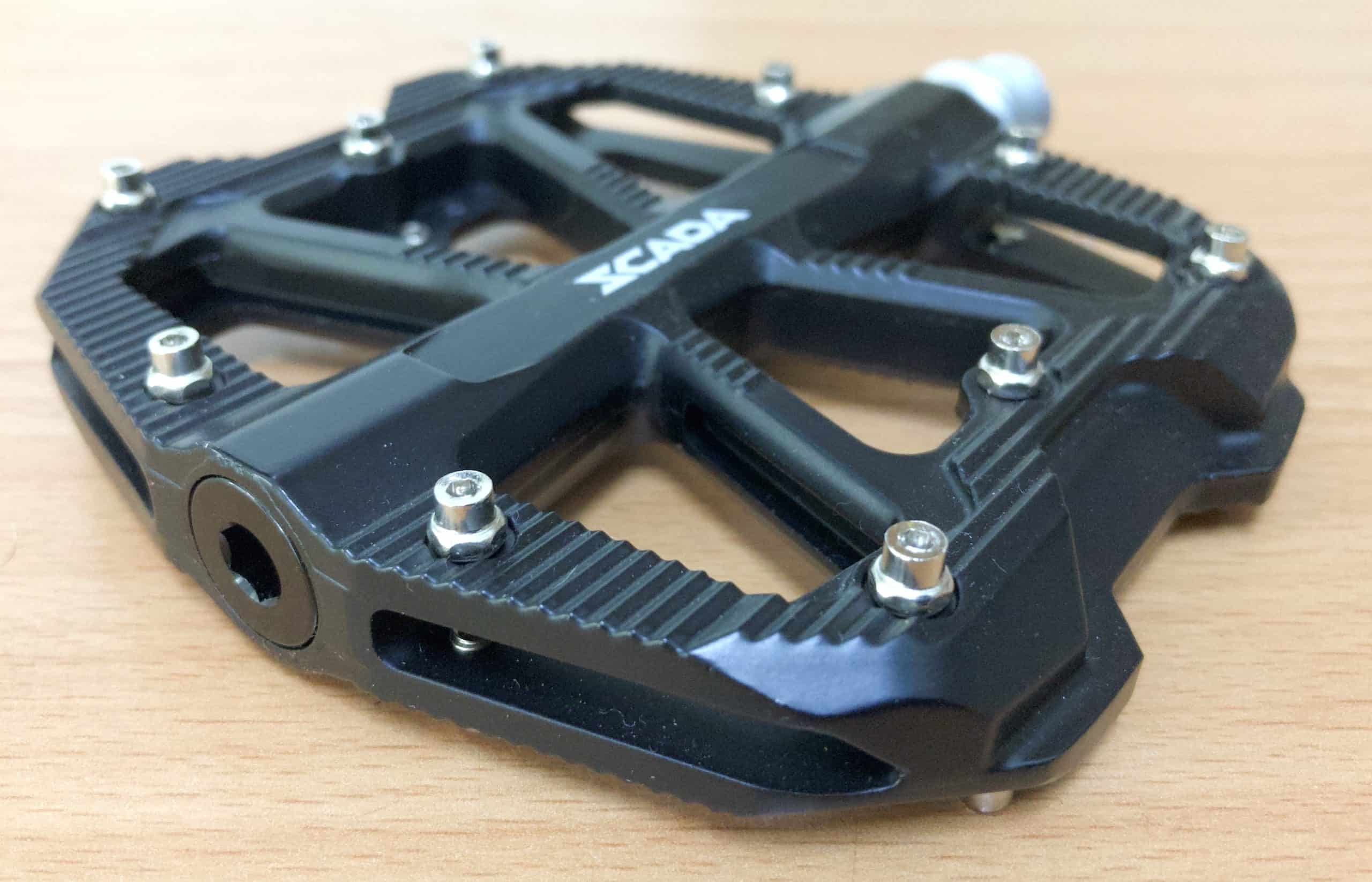
For higher end models, pins are removable and thus replaceable, since they can bend or break in some circumstances.
HYBRID BIKE PEDAL OPTIONS & MODELS
I firstly look several hybrid pedal types giving you an idea of the structure and function of this pedal type.
Note that SCADA is the manufacturing source for many (well-known) brands—we don’t yet sell our own branded hybrid pedals direct.
Our MO is to work through the details of a hybrid bike pedal design with a contracting brand to arrive at their unique model.
Discussions begin with the base designs below and then work towards realizing the brand’s design vision.
Although any design is theoretically possible, many brands are happy to order a batch based on the existing model catalogue as is.
Let’s turn to a look at some of these in the next section.
Selected Basic Hybrid Bike Pedals
You could probably call this an entry level hybrid pedal for road due to the model’s simplicity.
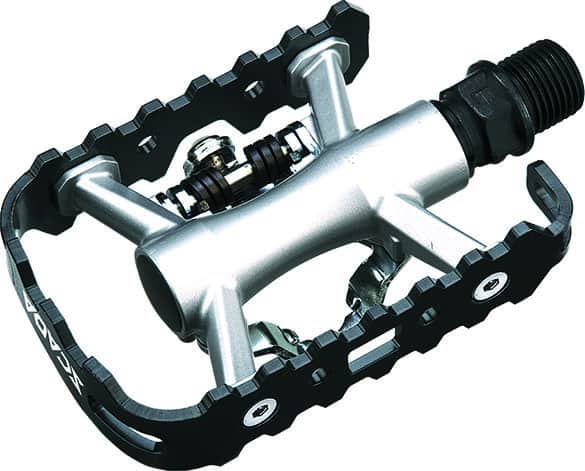
The serrated edge cage forming a pedal platform of sorts on both sides provides good grip on both sides.
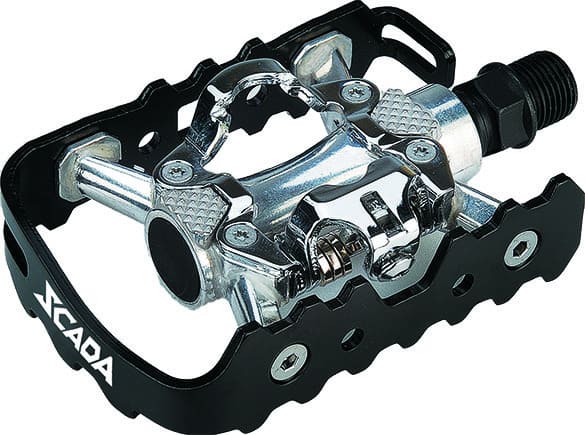
The bracket for clipping in is located on the flip side.
These may look like a cheap pair of pedals, but they function effectively as hybrid bike pedals.
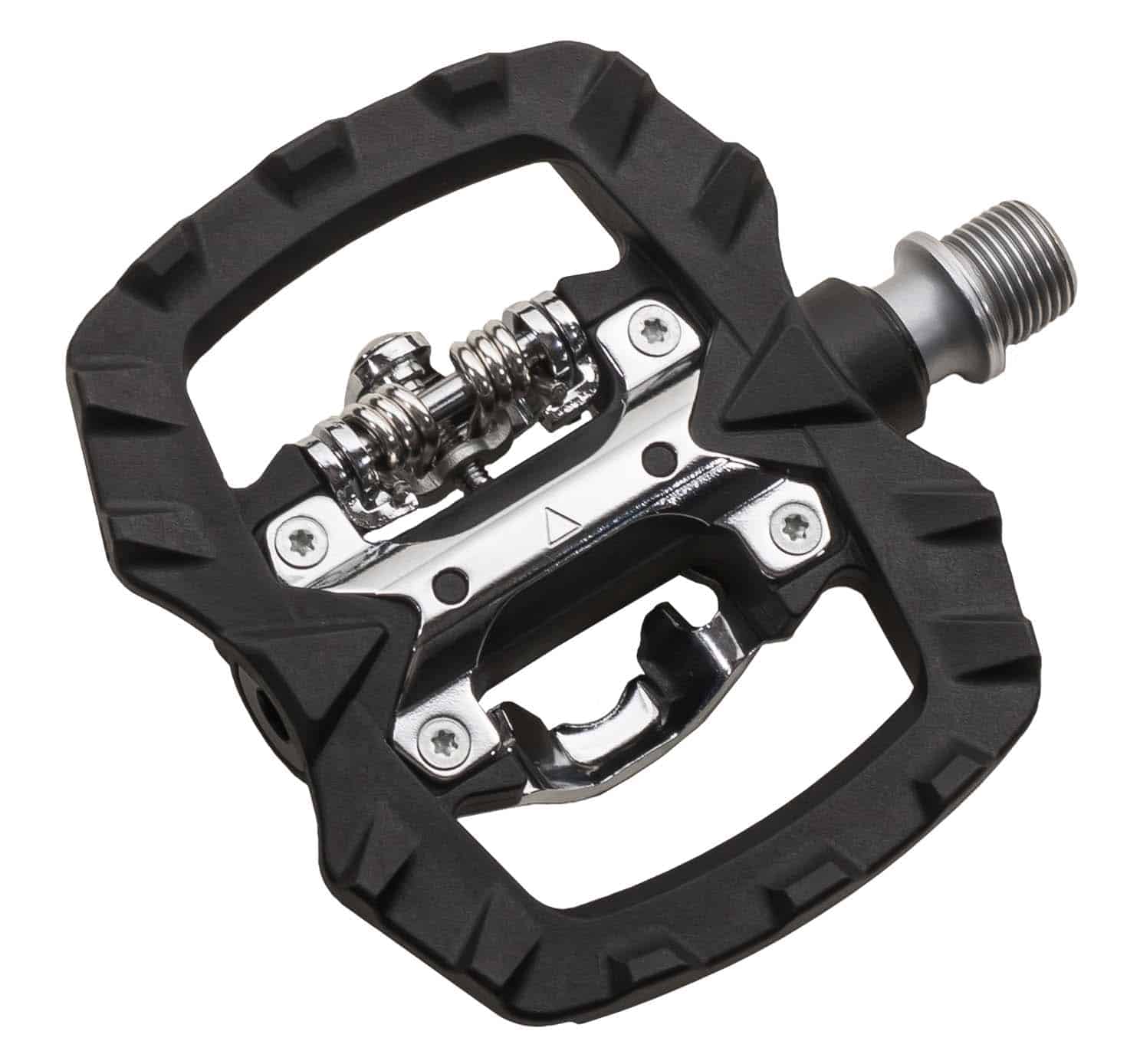
At a slightly higher level you move to a basic—classic—flat pedal.
Entry level MTB for this one, definitely. Certainly appropriate on a road bike or even trekking bike.
Enhanced grip is provided by the bosses positioned around the platform—no need for them on the other side, of course, since you’ll be clipping into the cleat on that side.

This more elegant model takes it up a notch higher and would be very appropriate on a city bike or some sort of commuting bike.
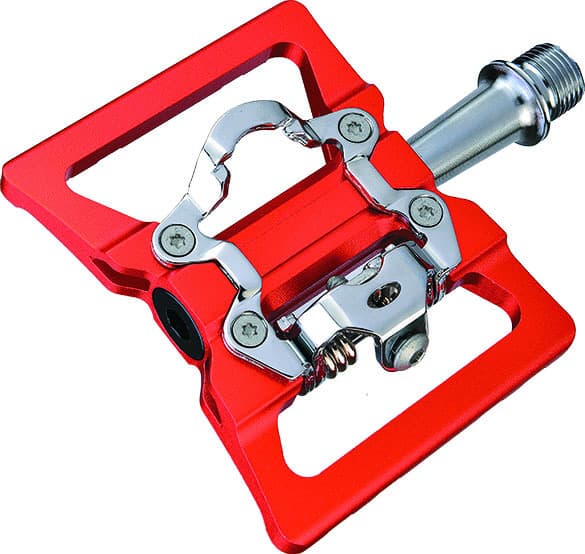
Flip it over to slot in the cleat.
Note the position of the cleat on the protruding lower edge of the pedal axle cavity.
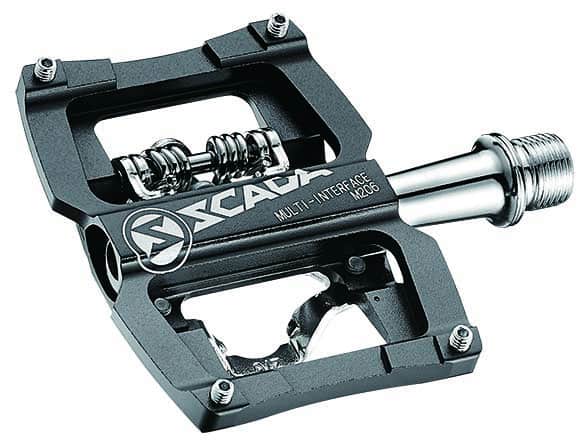
We step it up a little more with this one: the (replaceable) pins provide sturdy grip with one on each corner.
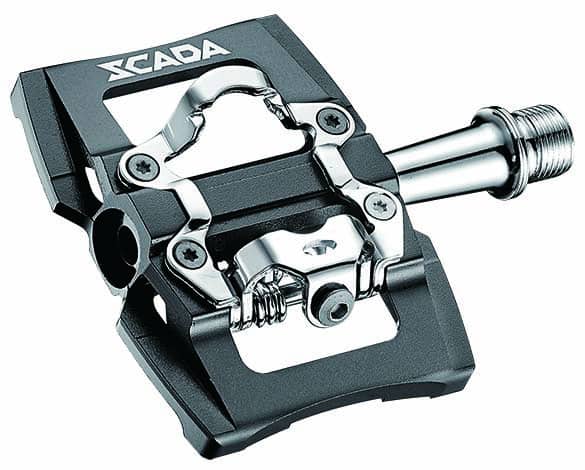
Flip it round for instant step-in to engage the cleat.
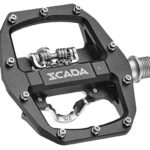
You might not consider this road cycling, but it would suit any other cycling mode.
Good as a mid-level MTB hybrid bike pedal since you’ve upped the number of pins, each of which can also be removed and replaced by Allen wrench.
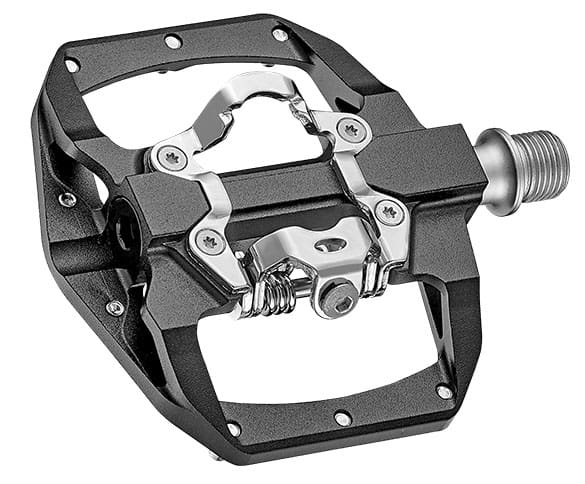
Step straight into the cleat.
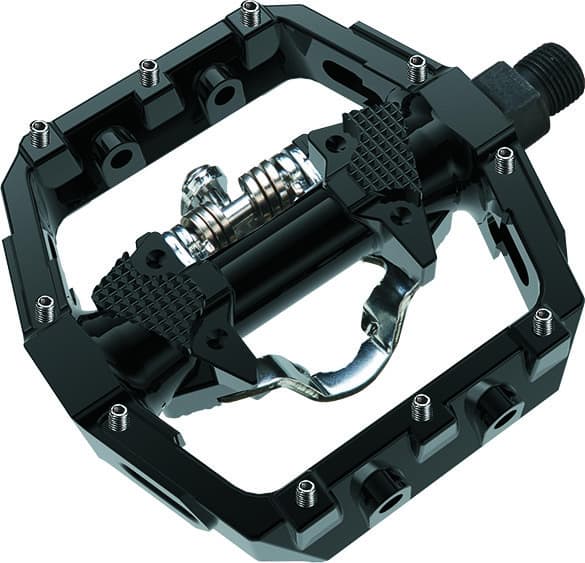
A bit more heavy duty than the previous model.
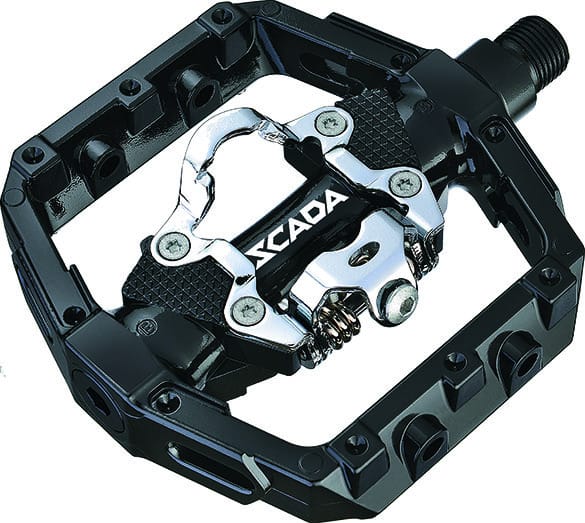
The corrugations on either side of the bracket enhance grip.
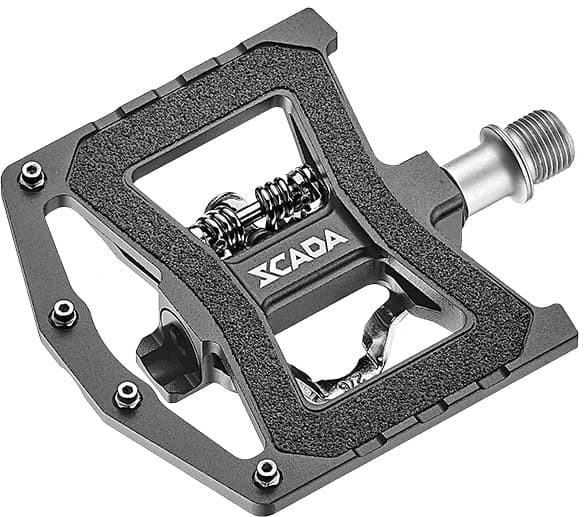
Another possibility is the combination of ‘sandpaper’ and pins.
The pins help prevent a cyclist’s foot slipping sideways, although the sandpaper makes it more a city/commuting pedal than MTB, which is a matter of style and thus personal preference than anything else.
Pop Up Hybrid Bike Pedal Models
This variation on hybrid bike pedal design is arguably the most versatile.
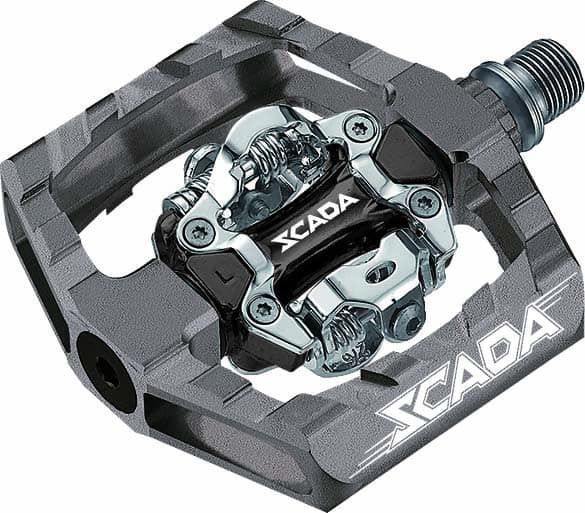
A rider doesn’t have to consciously select the correct surface, bracket or non-bracketed platform.
Either side will accept a cleat or serve as a level platform for a shoe.
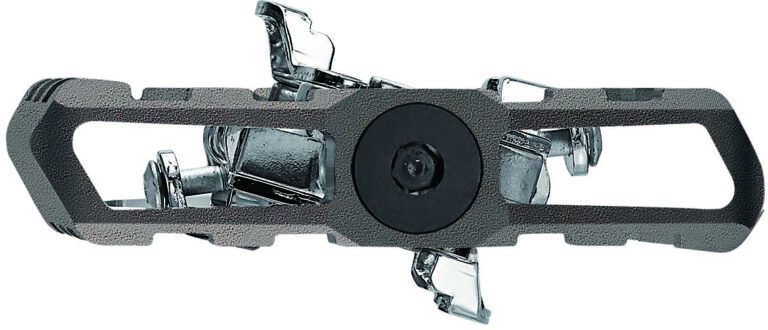
The bracket’s platform rotates out of the way with pressure from the sole of a shoe.
Or slot a cleated shoe into the bracket.
The bracket on this model rotates through 15 degrees, with 12 degrees being common amongst this type of hybrid pedal.
A rotating bracket overcomes the problem with hybrid bike pedals in that the rider has to look down to select the appropriate side.
Otherwise you’ve got a 50/50 chance of being wrong when attempting to place a foot on a hybrid pedal’s platform without looking.
You still have to look when clicking into the bracket, of course. But for some cyclists., the extra measure of convenience makes pop up pedals the right choice for them.
Some Popular Retail Models
Here are a selection of hybrid bike pedals available online or over-the-counter.
iSSi sell a range of performance-oriented hybrid bike pedals.

Road cyclists will be most familiar with this design, which superficially resembles the clip-in body section of a standard clipless road pedal.
Whereas a standard clipless road pedal upper surface is designed to accept a clipless shoe cleat, on this model a cyclist’s shoe sits on the platform, traction coming from the four pins.

Access the cleat by flipping the pedal over.
If this was a non-hybrid clipless road pedal, it would hang down under the weight of the tension mechanism (spring, bolt and supporting bracket) integrated into the rear of the pedal.
Since that mechanism is integrated into the bracket on the underside, this hybid pedal’s weight is distributed along its length, causing it to sit at whatever angle a cyclist likes, including level.
Crankbrothers produce quality products across the main bicycle component categories.

Their Double Shot hybrid bike pedal scores a 4.5 star rating on Amazon, a very well recevied model.
Pins, bosses, and corrugations populate the platform surface with the step-in (“egg beater” proprietary) cleat easily accessible on the flip side.
REMOVING & INSTALLING HYBRID BIKE PEDALS
If you intend installing a pair of hybrid bike pedals, knowledge of what tool to use and howto use it is essential.
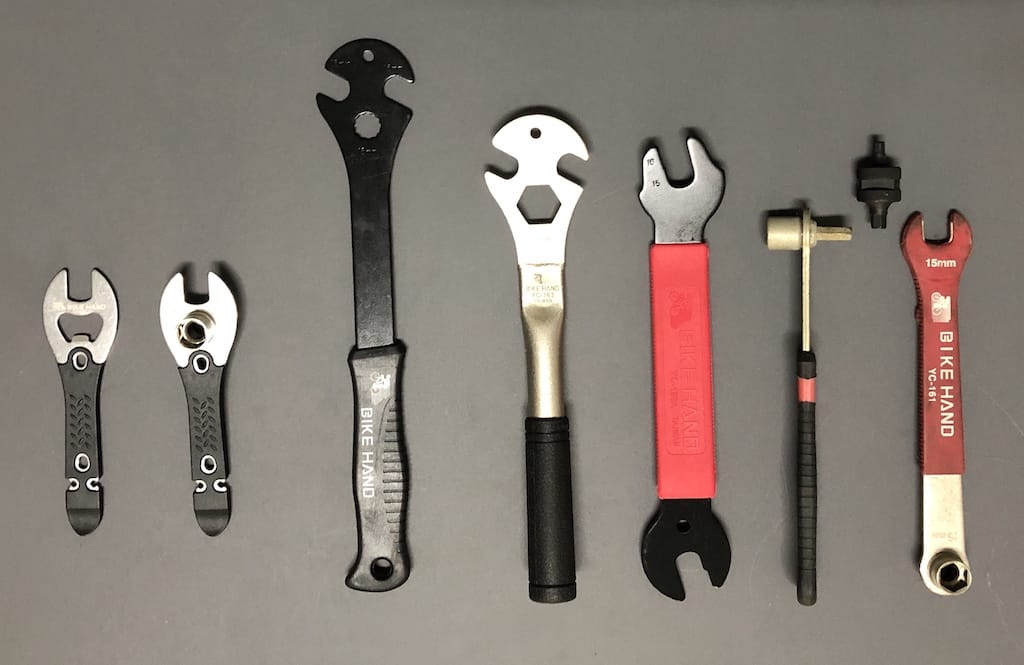
There’s a wide range of pedal wrenches available for the job.
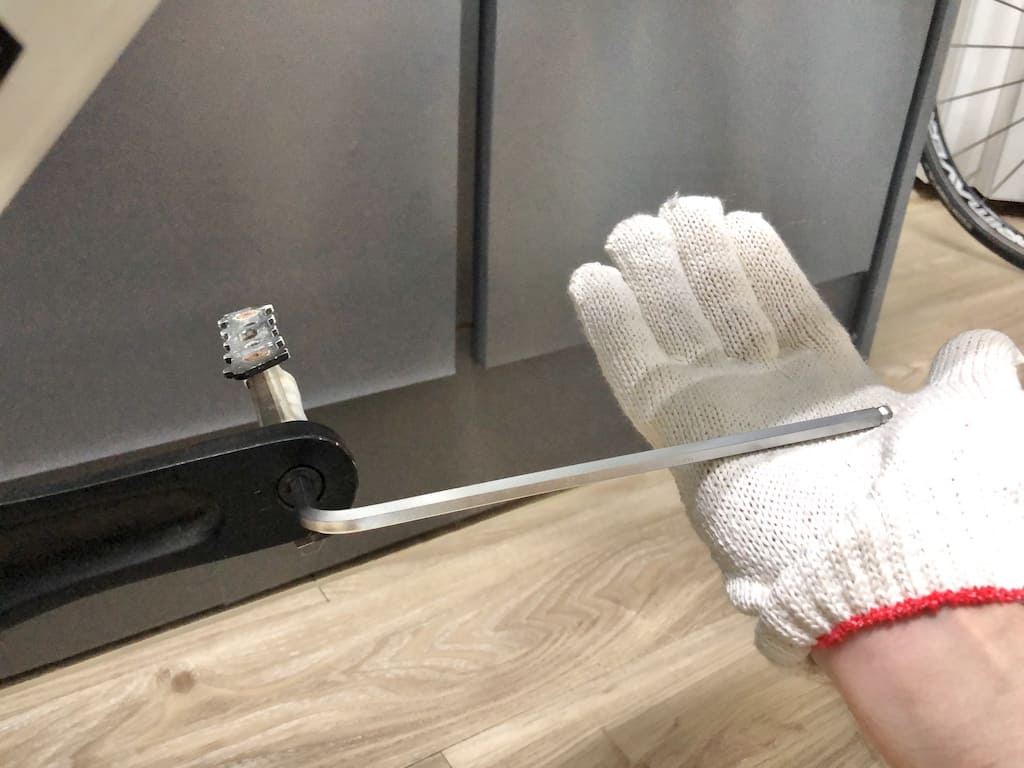
First and foremost is a 6mm (or sometimes 8mm) Allen wrench.
A blow upwards should be enough to break most pedals free of the crank thread.
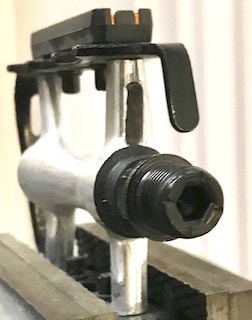
This way you can tighten and loosen a pedal by means of the hex socket in the end of the axle.

Getting a dedicated wrench just for pedals is an alternative to using an Allen wrench, which can be quite hard to use on stubborn pedals.

Otherwise a wrench fitting the axle nut adjacent to the pedal threads will do. A long-handled one like this makes short work of most stubborn pedals.
I’ve concentrated on removal in this section since it tends to be more challenging than installation.
Check out SCADA’s posts on:
- all aspects of pedal removal and installation
- pedal wrenches and techniques
FINAL COMMENTS
Hopefully you now know more of the nature and scope of hybrid bike pedals having read this far in the article.
If you are a brand looking for an OEM or ODM partner, get in touch: we’ll make it happen.